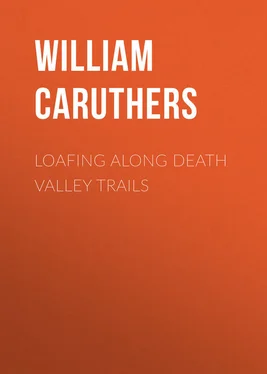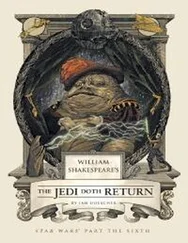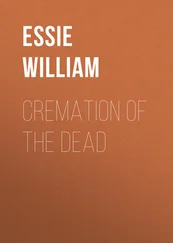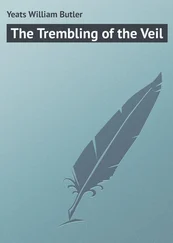William Caruthers - Loafing Along Death Valley Trails
Здесь есть возможность читать онлайн «William Caruthers - Loafing Along Death Valley Trails» — ознакомительный отрывок электронной книги совершенно бесплатно, а после прочтения отрывка купить полную версию. В некоторых случаях можно слушать аудио, скачать через торрент в формате fb2 и присутствует краткое содержание. Жанр: foreign_language, foreign_prose, на английском языке. Описание произведения, (предисловие) а так же отзывы посетителей доступны на портале библиотеки ЛибКат.
- Название:Loafing Along Death Valley Trails
- Автор:
- Жанр:
- Год:неизвестен
- ISBN:нет данных
- Рейтинг книги:5 / 5. Голосов: 1
-
Избранное:Добавить в избранное
- Отзывы:
-
Ваша оценка:
- 100
- 1
- 2
- 3
- 4
- 5
Loafing Along Death Valley Trails: краткое содержание, описание и аннотация
Предлагаем к чтению аннотацию, описание, краткое содержание или предисловие (зависит от того, что написал сам автор книги «Loafing Along Death Valley Trails»). Если вы не нашли необходимую информацию о книге — напишите в комментариях, мы постараемся отыскать её.
Loafing Along Death Valley Trails — читать онлайн ознакомительный отрывок
Ниже представлен текст книги, разбитый по страницам. Система сохранения места последней прочитанной страницы, позволяет с удобством читать онлайн бесплатно книгу «Loafing Along Death Valley Trails», без необходимости каждый раз заново искать на чём Вы остановились. Поставьте закладку, и сможете в любой момент перейти на страницу, на которой закончили чтение.
Интервал:
Закладка:
Note. Early writers refer to Pau Eutahs, Pah Utes, Paiuches, Pyutes, and Paiutes. The word Piute is believed to mean true Ute.
Bancroft claimed the Piutes and Pah Utes were separate tribes, the latter being the Trout or Ochi Indians of Walker River; the former the Tule (or Toy) Indians of Pyramid Lake.
There was an undetermined number of branches of the original Utah stock. Besides the above, there was another tribe called by other Indians, Cozaby Piutes, Cozaby being the Indian name of a worm that literally covered the shores of Mono Lake. This worm was a principal food of the tribe.
Though “Piute” is the spelling justifiably used throughout the region, “Pahute” was chosen a few years ago by a group of scholars as the preferable form.
Chapter VIII
Desert Gold. Too Many Fractions
On the Nevada desert wind-whipped Mount Davidson (or Sun Mountain) guided the Forty Niners across the flat Washoe waste. At its foot they rested and cursed it because it impeded their progress to the California goldfields. Ten years later they rushed back because it had become the fabulous Comstock, said to have produced more than $880,000,000, though the Nevada State bureau of mines places the figure at $347,892,336. The truth lies somewhere between.
“Pancake” Comstock had acquired, more by bluff and cunning than labor, title to gold claims others had discovered and cursed a “blue stuff” that slowed the recovery of visible particles of gold. Later the “blue stuff” was blessed as incredibly rich silver. A mountain of gold and silver side by side. It just couldn’t be.
A new crop of overnight millionaires. New feet feeling for the first step on the social ladder. The Mackays, the Floods, the Fairs, the Hearsts.
All this was more like current than twenty year old history to Jim Butler on May 18, 1900, when his hungry burro strayed up a hill in search of grass. Soon a city stood where the burro ate and soon adventurers were poking around in the canyons of Death Valley, 66 miles south.
Jim Butler, more rancher than gold hunter was a likable happy-go-lucky fellow, who could strum a banjo and sing a song. But when he found the burro in Sawtooth Pass he saw a ledge which looked as if it might have values. Born in El Dorado county in California in 1855, Butler was more or less gold conscious, but unexcited he stuck a few samples in his pocket and went on after the burro.
A story survives which states that a half-breed Shoshone Indian known as Charles Fisherman had told Butler of the existence of the ore without disclosing its location and that Butler was actually searching for it when the burro strayed. The preponderance of evidence, however, indicates that Butler was en route to Belmont to see his friend, Tasker Oddie, who was batching there in a cabin. He gave Oddie one of the samples and after his visit, left for home.
Oddie laid the sample on a window sill and forgot it.
In Klondike a few days later, Butler showed another sample to Frank Higgs, an assayer. Half in jest he said: “Frank, I’ve no money to pay for an assay, but I’ll cut you in on this stuff if it shows anything.”
Higgs looked at the sample and returned it to Butler: “Just a waste of time. Forget it.”
Later in Belmont Henry Broderick, a prospector dropped in for a visit with Oddie and noticed the sample Butler had given Oddie and looked it over. “This ore has good values,” he told Oddie. “It’s worth investigating.” Oddie knew that Broderick’s opinion was not to be underrated.
Oddie was a young lawyer with little practice and a salary of $100 a year as District Attorney. Belmont had a population of 100. Oddie didn’t have two dollars to risk, but he took the sample to W. C. Gayhart at Austin and offered Gayhart a fractional interest if he’d assay it. With few customers, Gayhart took a chance.
The ore showed values and Oddie was mildly excited. Butler lived 35 miles away in wild, difficult country and Oddie wrote him, enclosing the assay. Several weeks passed before Butler received the letter. Then Butler and his wife returned to Belmont only to find Oddie could not go with them. Jim and Mrs. Butler now returned home, loaded provisions, tools, and camp equipment in a wagon and three days later, Aug. 26, 1900, they reached Sawtooth Pass and made camp.
The Butlers staked out eight claims. Jim took for himself the one he considered best. He named it The Desert Queen. Mrs. Butler chose another and called it Mizpah. Jim located another for Oddie and named it Burro. The best proved to be Mrs. Butler’s Mizpah.
Returning to Belmont, they found Oddie at home. The matter of recording the location notices had to be attended to. “That will cost ten or fifteen dollars,” Butler said. Neither of them had any money. Wils Brougher was recorder of Nye county and Oddie’s friend, so Oddie made a proposition to Brougher. “If you’ll pay the recorder’s fees we’ll give you an eighth.”
Brougher said, “Nye county is one of the largest counties in the United States, but there are only 400 people in it and I’m not getting many fees these days. Leave ’em.”
After they’d gone Brougher looked at the assay Oddie had left and decided to take a chance. The setup was now: Butler and his wife five-eighths, Oddie, Brougher, and Gayhart, one-eighth each.
They managed to pool resources and obtained $25 in cash to provide material and provisions.
Brougher, Oddie, Jim, and Mrs. Butler set out in October, 1900. Mrs. Butler did the cooking while the men dug, drilled, and blasted two tons of ore. The ore was sacked and hauled 150 miles to Austin and shipped to a San Francisco smelter. The returns showed high values but still they had a major problem – money to develop the claims. Because the country had been prospected and pronounced worthless, men of millions were not backing a banjo-picking rancher and a young lawyer with no money and few clients. The answer was leasing to idle miners willing to gamble muscle against money. The venture made many of them rich. The others recovered more than wages. As the leases expired the owners took them over.
The camp where Mrs. Butler cooked became the site of the Mizpah Hotel and the City of Tonopah and the hill where the burro strayed produced many millions.
There are several versions of the Butler discovery and the writer does not pretend that his own is the true one. He can only say that he knew many of those who were first on the scene and some of those who held the first and best leases, and his conclusions are based on their personal narratives.
Oddie became one of the moguls of mining, Nevada’s governor, and a senator of the United States.
Twenty-six miles south of Tonopah was a place known as Grandpa, so named because there were always a few old prospectors camped at the water hole known as Rabbit Springs. These patriarchs had combed the desert about, for years without success.
Al Myers, a prospector working on a hill nearby, came to the Grandpa Spring to fill a barrel of water and found his friend, Shorty Harris, who had been camping there, packing his burros to leave. “Better hang around, Shorty,” Al advised. “I’m getting color.”
“Luck to you,” Shorty laughed. “But any place where these old grandpas can’t find color, is no place for me.”
In six weeks Myers and Tom Murphy made the big strike (1903) and Grandpa became Goldfield – one of the West’s most spectacular camps. Some of the more promising claims of Goldfield were leased, the most valuable being that of Hays and Monette, on the Mohawk. In 106 days the lease produced $5,000,000.
Out of the Mohawk one car was shipped which yielded over $579,000 and ore in all of the better mines was so rich that Goldfield quickly became the high-grader’s paradise. Though wages at Tonopah were twice those paid at Goldfield, miners deserted the older camp for the lower wage and made more than the difference by concealing high-grade in the cuffs of their overalls or in other ingenious receptacles built into their clothing. Miners and muckers took the girls of their choice out of honkies and installed them in cottages. More than one of these gorgeous creatures, having found her man in her boom-town crib, later ascended life’s grand stairway to live virtuously and bravely in a Wilshire mansion or a swank hotel.
Читать дальшеИнтервал:
Закладка:
Похожие книги на «Loafing Along Death Valley Trails»
Представляем Вашему вниманию похожие книги на «Loafing Along Death Valley Trails» списком для выбора. Мы отобрали схожую по названию и смыслу литературу в надежде предоставить читателям больше вариантов отыскать новые, интересные, ещё непрочитанные произведения.
Обсуждение, отзывы о книге «Loafing Along Death Valley Trails» и просто собственные мнения читателей. Оставьте ваши комментарии, напишите, что Вы думаете о произведении, его смысле или главных героях. Укажите что конкретно понравилось, а что нет, и почему Вы так считаете.












